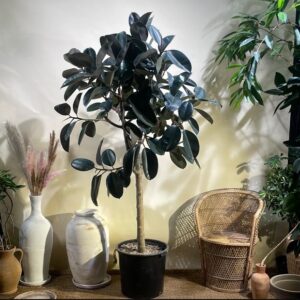Description
The Fuchsia Tree (1Yr Old ): A Colorful Addition to Your Indoor Space
The Fuchsia Tree (Fuchsia magellanica) is a stunning ornamental plant that brings a vibrant splash of color and a touch of elegance to indoor settings. With its exquisite, drooping flowers in shades of pink, purple, and red, this small tree is perfect for brightening up living rooms, entryways, or any corner of your home that could use a pop of color. In this article, we will explore how to successfully grow a Fuchsia Tree indoors, along with essential care tips to ensure it thrives in your home.
Why Choose a Fuchsia Tree?
The Fuchsia Tree stands out not only for its beauty but also for its adaptability to indoor environments. Here are a few reasons to consider this plant for your indoor space:
- Aesthetic Appeal: The lush foliage and striking flowers create a stunning focal point in any room.
- Attracts Pollinators: Its vibrant blooms are known to attract hummingbirds and butterflies, enhancing the liveliness of your indoor garden.
- Moderate Size: Typically growing between 4 to 10 feet, it fits well in most indoor spaces without overwhelming the area.
Ideal Growing Conditions
USDA Zones 7–10 – To ensure your Fuchsia Tree thrives indoors, consider the following growing conditions:
- Light: Fuchsia Trees prefer bright, indirect sunlight. Position your tree near a window that receives morning sun but is shaded in the afternoon to prevent leaf scorch. If natural light is limited, you can supplement with grow lights to mimic ideal conditions.
- Temperature: Aim for temperatures between 60°F to 75°F (15°C to 24°C). Protect your tree from cold drafts and extreme heat, as Fuchsia Trees can be sensitive to temperature fluctuations.
- Humidity: Fuchsia Trees thrive in humid environments. If your home is dry, consider using a humidifier or placing a tray of water with pebbles under the pot to increase humidity levels. Misting the leaves occasionally can also help maintain moisture.
Potting and Soil
- Container: Choose a pot with drainage holes to prevent water accumulation and root rot. A 10-12 inch pot is typically suitable for indoor growth.
- Soil: Use well-draining potting mix rich in organic matter. A mix of peat, pine bark, and perlite works well, providing the necessary drainage while retaining moisture.
Watering Routine
- Watering: Keep the soil consistently moist but not soggy. Water when the top inch of soil feels dry to the touch. During the growing season (spring and summer), you may need to water more frequently, while reducing frequency in the fall and winter when growth slows.
Fertilization
- Feeding: During the growing season, apply a balanced, water-soluble fertilizer every 4 to 6 weeks to encourage healthy growth and abundant blooms. Look for fertilizers with equal ratios of nitrogen, phosphorus, and potassium (e.g., 10-10-10) or a fertilizer specifically formulated for flowering plants.

Pruning and Maintenance
- Pruning: Regular pruning helps maintain the shape of your Fuchsia Tree and promotes bushier growth. Remove dead or damaged branches and spent flowers to encourage new blooms. Pruning can be done in late winter or early spring before the growing season begins.
- Pests and Diseases: Keep an eye out for common pests like aphids, spider mites, and whiteflies. Regularly inspect your plant and treat infestations with insecticidal soap or neem oil if necessary. Ensure proper air circulation to prevent issues like powdery mildew, which can occur in humid conditions.
Conclusion
The Fuchsia Tree (Fuchsia magellanica) is an enchanting addition to any indoor space, providing not only beautiful blooms but also a sense of tranquility and connection to nature. By following these care tips, you can create the ideal environment for your Fuchsia Tree to thrive, bringing vibrant color and life into your home. With the right attention and care, this delightful tree will reward you with stunning floral displays and become a cherished part of your indoor garden.






Reviews
There are no reviews yet.